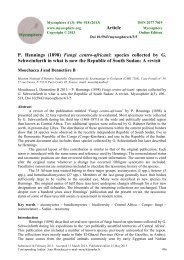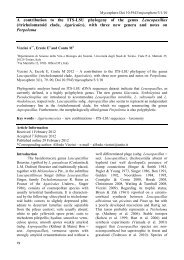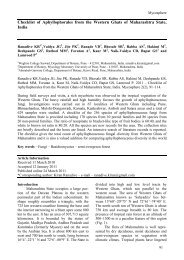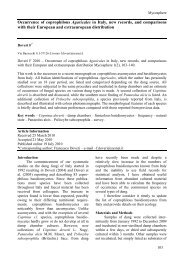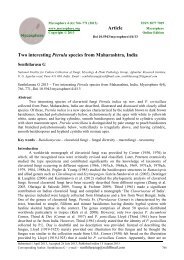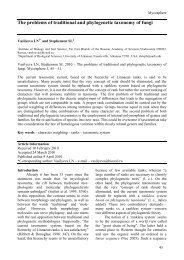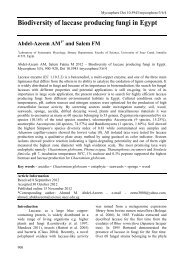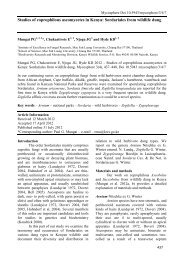Notes on three lichenicolous species of Acremonium including two
Notes on three lichenicolous species of Acremonium including two
Notes on three lichenicolous species of Acremonium including two
You also want an ePaper? Increase the reach of your titles
YUMPU automatically turns print PDFs into web optimized ePapers that Google loves.
Mycosphere Doi 10.5943/mycosphere/3/5/10<br />
<str<strong>on</strong>g>Notes</str<strong>on</strong>g> <strong>on</strong> <strong>three</strong> <strong>lichenicolous</strong> <strong>species</strong> <strong>of</strong><br />
Acrem<strong>on</strong>ium <strong>including</strong> <strong>two</strong> new <strong>species</strong><br />
Brackel Wv 1* , Etayo J 2 and Lechat C 3<br />
1 Wolfgang v<strong>on</strong> Brackel, Institut für Vegetati<strong>on</strong>skunde und Landschaftsökologie, Georg-Eger-Str. 1b, D-91334<br />
Hemh<strong>of</strong>en, Germany. – e-mail: wolfgang.v<strong>on</strong>.brackel@ivl-web.de<br />
2 Javier Etayo, Navarro Villoslada, 16-3° dcha., E-31003 Pampl<strong>on</strong>a, Spain. – e-mail: jetayosa@pnte.cfnavarra.es<br />
3 Christian Lechat, Asc<strong>of</strong>rance, 64 route de Chizé, 79360 Villiers en Bois, France. – e-mail: lechat@asc<strong>of</strong>rance.fr<br />
Brackel Wv, Etayo J, Lechat C 2012 – <str<strong>on</strong>g>Notes</str<strong>on</strong>g> <strong>on</strong> <strong>three</strong> <strong>lichenicolous</strong> <strong>species</strong> <strong>of</strong> Acrem<strong>on</strong>ium.<br />
Mycosphere 3(5), 854–862, Doi 10.5943 /mycosphere/3/5/10<br />
Two new <strong>species</strong> <strong>of</strong> <strong>lichenicolous</strong> fungi: Acrem<strong>on</strong>ium pertusariae <strong>on</strong> Pertusaria spp. and A.<br />
bavaricum <strong>on</strong> Melanelixia glabratula are described. A new combinati<strong>on</strong> is proposed for<br />
Dendrodochium subeffusum.<br />
Key words – Anamorph fungi – Bi<strong>on</strong>ectriaceae – Hyphomycetes<br />
Article Informati<strong>on</strong><br />
Received 4 September 2012<br />
Accepted 14 September 2012<br />
Published <strong>on</strong>line 30 September 2012<br />
Corresp<strong>on</strong>ding author: Wolfgang v<strong>on</strong> Brackel – e-mail – wolfgang.v<strong>on</strong>.brackel@ivl-web.de<br />
Introducti<strong>on</strong><br />
The genus Acrem<strong>on</strong>ium currently<br />
comprises more than 100 <strong>species</strong> (Diederich<br />
& Braun 2009); most <strong>of</strong> them are<br />
saprophytes, but some are parasites <strong>of</strong> other<br />
organisms (Gams 1971, Hawksworth 1972).<br />
Hawksworth (1979) recorded four Acrem<strong>on</strong>ium<br />
<strong>species</strong> known <strong>on</strong>ly from lichens and<br />
<strong>on</strong>e more fortuitously <strong>lichenicolous</strong>. Now<br />
nine <strong>species</strong> are known as living <strong>on</strong> lichens,<br />
<strong>of</strong> which seven are described in the genus<br />
Acrem<strong>on</strong>ium and <strong>two</strong> as anamorphs <strong>of</strong><br />
Pr<strong>on</strong>ectria. Within the genus Acrem<strong>on</strong>ium<br />
Gams (1971) and Morgan-J<strong>on</strong>es & Gams<br />
(1982) described or combined the secti<strong>on</strong>s<br />
Albo-lanosa, Chaetomioides, Gliomastix,<br />
Nectroidea, and Simplex (Acrem<strong>on</strong>ium).<br />
Lowen (1995) added the secti<strong>on</strong><br />
Lichenoidea, in which most <strong>of</strong> the<br />
<strong>lichenicolous</strong> <strong>species</strong> are included.<br />
During our studies in Spain, southern<br />
Italy, and southern Germany, we found <strong>two</strong><br />
undescribed taxa <strong>of</strong> Acrem<strong>on</strong>ium as<br />
probable parasites <strong>on</strong> lichens. The <strong>two</strong> new<br />
<strong>species</strong> are described and illustrated in this<br />
paper and a <strong>species</strong> <strong>of</strong> Dendrodochium is<br />
recombined into Acrem<strong>on</strong>ium.<br />
Materials and methods<br />
Morphological and anatomical<br />
observati<strong>on</strong>s were made using standard<br />
microscopic techniques. Microscopic<br />
measurements were made <strong>on</strong> hand-cut<br />
secti<strong>on</strong>s mounted in water with an accuracy<br />
up to 0.5 µm. Measurements <strong>of</strong> c<strong>on</strong>idia are<br />
recorded as (minimum–) X-σ X – X+σ X (–<br />
maximum) followed by the number <strong>of</strong><br />
measurements. The specimens are deposited<br />
in the private herbaria <strong>of</strong> the authors, the<br />
holotypes <strong>of</strong> Acrem<strong>on</strong>ium pertusariae and<br />
A. bavaricum in M, cultures <strong>of</strong> the<br />
anamorphs at CIRM.<br />
854
Results<br />
Acrem<strong>on</strong>ium pertusariae Brackel & Etayo,<br />
sp. nov. Figs 1–2<br />
MycoBank 519867<br />
Etymology – pertaining to the host<br />
genus Pertusaria.<br />
Diagnosis – Col<strong>on</strong>iae superficiales,<br />
pulviniae, pallide roseae, 200–300 µm diam.<br />
Hyphae hyalinae, septatae, leves, 3–4 µm<br />
latae. C<strong>on</strong>idiophora ramosa, septata,<br />
hyalina. Cellulae c<strong>on</strong>idiogenae hyalinae,<br />
leves, subulatae, phialidicae, (15–)25–45 ×<br />
1.5–4 µm. C<strong>on</strong>idia solitaria, levia, guttulata,<br />
late ellipsoidea, apici rotundo, basi truncata<br />
vel rotunda, hyalina, (4.5–)5–7(–8.5) × (3–<br />
)3.4–4.3(–4.5) µm. Clamydosporae absunt;<br />
teleomorphosis ignota.<br />
Holotype – Italy, Basilicata, Prov. di<br />
Potenza, Bosco Teduri near Bagni, old<br />
beech forest, <strong>on</strong> Pertusaria pertusa <strong>on</strong><br />
Fagus sylvatica, 1260 m, 40°06′26′′N,<br />
15°58′25′′E, W. & G. v. Brackel, 16.8.2010<br />
(M – holotypus, hb ivl 5498 – isotypus,<br />
culture deposited at CIRM).<br />
Descripti<strong>on</strong> – Col<strong>on</strong>ies discrete to<br />
c<strong>on</strong>fluent, superficial, tufted, pale pinkish,<br />
building sporodochial-like cushi<strong>on</strong>s 200–<br />
300 µm; mycelium partly immersed, hyphae<br />
flexuose, thin-walled, smooth, hyaline, 3–4<br />
µm wide. C<strong>on</strong>idiophores semi-macr<strong>on</strong>ematous,<br />
richly branched, septate, hyaline,<br />
smooth. C<strong>on</strong>idiogenous cells discrete,<br />
terminal, hyaline, thin-walled, smooth,<br />
subulate, phialidic, (15–)25–45 µm l<strong>on</strong>g, 2–<br />
4 µm wide at the base and 1.5–2 µm at the<br />
apex. Both c<strong>on</strong>idiophores and c<strong>on</strong>idiogenous<br />
cells c<strong>on</strong>tain many small (or later<br />
some big) oil guttules. C<strong>on</strong>idia solitary,<br />
broadly ellipsoid, rounded at the apex,<br />
slightly truncate at the base or rounded,<br />
simple, hyaline, smooth, guttulate, (4.5–)5–<br />
7(–8.5) × (3–)3.4–4.3(–4.5) µm, l/b = (1.1–<br />
)1.3–2.4(–2.8), (n = 72). Clamydospores<br />
absent, teleomorph unknown.<br />
Features in culture at 25°C at day<br />
light <strong>on</strong> Difco PDA c<strong>on</strong>taining 5mg/L<br />
streptomycin– Col<strong>on</strong>ies fast growing, greybrown<br />
whitish from above, brownish from<br />
below, very fluffy, abundantly producing<br />
c<strong>on</strong>idia. Vegetative hyphae thin-walled,<br />
smooth, hyaline, 2–4 µm wide.<br />
Mycosphere Doi 10.5943/mycosphere/3/5/10<br />
C<strong>on</strong>idiophores semi-macr<strong>on</strong>ematous, branched,<br />
septate, hyaline, smooth. C<strong>on</strong>idiogenous<br />
cells discrete, terminal, hyaline, thinwalled,<br />
smooth, subulate, phialidic, c. 15–30<br />
µm l<strong>on</strong>g, 1.5–2 µm wide at the base and 1–<br />
1.5 µm at the apex. Both c<strong>on</strong>idiophores and<br />
c<strong>on</strong>idiogenous cells c<strong>on</strong>tain several<br />
c<strong>on</strong>spicious guttules. C<strong>on</strong>idia solitary,<br />
ellipsoid, rounded at the apex, slightly<br />
truncate at the base or rounded, simple,<br />
hyaline, smooth, guttulate, (4–)4.5–7.4(–<br />
9.5) × (2–)2.1–2.8(–3) µm, l/b= (1.6–)2–<br />
2.9(–3.3) (n=20).<br />
Distributi<strong>on</strong> and hosts – Spain<br />
(Aragón, Navarra, País Vasco), Canary<br />
Islands (La Palma) and Italy (Basilicata), <strong>on</strong><br />
Pertusaria albescens, P. albescens var.<br />
corallina, and P. pertusa, thallus and<br />
apothecial warts. The fungus is apparently<br />
parasitic, as the infected parts <strong>of</strong> the host<br />
thallus become blackened and destroyed.<br />
Uninfected parts <strong>of</strong> the thallus were healthy<br />
and no other infecting fungus could be<br />
found in the type and some <strong>of</strong> the Spanish<br />
samples, but sometimes it lives together<br />
with other fungi, especially Pr<strong>on</strong>ectria<br />
pertusariicola. The latter <strong>species</strong> has<br />
already been recorded, as A. aff. spegazzinii<br />
D. Hawksw. in Etayo & López de Silanes<br />
(2008) and Etayo (2010), <strong>on</strong> Pertusaria<br />
albescens.<br />
Discussi<strong>on</strong> – The new <strong>species</strong><br />
bel<strong>on</strong>gs to the sect. Nectroidea, as the<br />
hyphae are thin-walled and not ch<strong>on</strong>droid,<br />
and the c<strong>on</strong>idiophores are richly branched. It<br />
clearly does not bel<strong>on</strong>g to the sect.<br />
Lichenoidea because <strong>of</strong> the lack <strong>of</strong> wall<br />
thickenings in the phialides and the broadly<br />
ellipsoid c<strong>on</strong>idia (l/b ratio < 2). According<br />
to Lowen (1995) there were <strong>on</strong>ly <strong>two</strong><br />
<strong>species</strong> <strong>of</strong> Acrem<strong>on</strong>ium found <strong>on</strong> lichens<br />
that do not bel<strong>on</strong>g to the Lichenoidea: A.<br />
psychrophilum (sect. Gliomastrix), and A.<br />
strictum (sect. Acrem<strong>on</strong>ium); both are<br />
distinguished from the new <strong>species</strong> by the<br />
features <strong>of</strong> their secti<strong>on</strong> (ch<strong>on</strong>droid hyphae<br />
respectively unbranched c<strong>on</strong>idiophores).<br />
Also A. hypholomatis, which was recently<br />
found growing <strong>on</strong> Physcia stellaris<br />
(Diederich & Braun 2009), is a member <strong>of</strong><br />
the sect. Lichenoidea. Within the sect.<br />
Nectrioidea <strong>on</strong>ly A. zeae has some similarity<br />
855
Mycosphere Doi 10.5943/mycosphere/3/5/10<br />
Fig. 1 – Acrem<strong>on</strong>ium pertusariae (holotypus) A c<strong>on</strong>idiophores with c<strong>on</strong>idiogenous cells and<br />
c<strong>on</strong>idia. B c<strong>on</strong>idia.<br />
with the new <strong>species</strong> (according to the key<br />
in Gams 1971), but this <strong>species</strong> has<br />
distinctly narrower c<strong>on</strong>idia (3.5–5.8 × 1.2–<br />
1.9 µm).<br />
Acrem<strong>on</strong>ium is <strong>on</strong>e <strong>of</strong> the genera<br />
c<strong>on</strong>sidered as anamorphs <strong>on</strong> Pr<strong>on</strong>ectria<br />
(Bi<strong>on</strong>ectriaceae) <strong>species</strong> (Rossman et al.<br />
1999). Five taxa <strong>of</strong> Bi<strong>on</strong>ectriaceae are<br />
known as parasites <strong>on</strong> the genus Pertusaria:<br />
Nectriopsis frangospora (<strong>on</strong> P. albescens,<br />
P. rubefacta), N. hirta (<strong>on</strong> P. albescens, P.<br />
pertusa), Pr<strong>on</strong>ectria pertusariicola (<strong>on</strong> P.<br />
albescens, P. pertusa, Pertusaria spp.),<br />
Pr<strong>on</strong>ectria sp. (sensu Etayo 2006, <strong>on</strong><br />
Pertusaria hymenea) and Trich<strong>on</strong>ectria<br />
pertusariae <strong>on</strong> P. amara var. slesvicensis<br />
and P. ophtalmiza. Am<strong>on</strong>g these <strong>species</strong> P.<br />
pertusariicola seems to be the more<br />
widespread and comm<strong>on</strong>. It is very comm<strong>on</strong><br />
in humid beech forests in oceanic northern<br />
Spain and not rare in the higher mountains<br />
<strong>of</strong> southern Italy. Although not in the type<br />
material, Acrem<strong>on</strong>ium pertusariae has been<br />
collected <strong>on</strong> some occasi<strong>on</strong>s as well in<br />
Spain, as in Italy, growing together or over<br />
thallus infected with P. pertusariicola<br />
(which might be the teleomorph <strong>of</strong> the new<br />
<strong>species</strong>); in Spain sometimes also with a<br />
Fusarium <strong>species</strong> which we will study in the<br />
future. The presence <strong>of</strong> <strong>two</strong> different<br />
c<strong>on</strong>idial genera <strong>on</strong> Pertusaria thalli infected<br />
by P. pertusariicola and the fact that several<br />
thalli infected by Acrem<strong>on</strong>ium do not show<br />
the presence <strong>of</strong> Pr<strong>on</strong>ectria, we cannot<br />
ensure the teleomorph-anamorph c<strong>on</strong>necti<strong>on</strong>.<br />
Moreover, the anamorph <strong>of</strong> P.<br />
pertusariicola in culture is clearly distinguished<br />
from A. pertusariae (see below)<br />
even in culture by larger c<strong>on</strong>idiogenous<br />
cells and l<strong>on</strong>ger and thiner c<strong>on</strong>idia in A.<br />
pertusariae.<br />
Additi<strong>on</strong>al specimens – Spain:<br />
Álava, entre Santa Cruz y Oteo, pequeño<br />
cañón que atraviesa la carretera, <strong>on</strong> P.<br />
albescens <strong>on</strong> Acer, 650 m, 42º42'13''N,<br />
2º21'21''W, 4.9.2010, J. Etayo 26227 (hb.<br />
Etayo). Álava, Muniain, Sª de Entzía,<br />
robledal centenario de Muniain, <strong>on</strong> P.<br />
albescens <strong>on</strong> Q. robur, 750 m, 42º50’N,<br />
2º20’W, 6.2007, J. Etayo 24235 (hb. Etayo).<br />
Ibidem, 9.2007, J. Etayo 24323 (hb. Etayo).<br />
Ibidem, 26401 (hb. Etayo, culture deposited<br />
856
at CIRM). Álava, K<strong>on</strong>trasta, bosque de<br />
Quercus x pyrenaica, por sendero desde el<br />
pueblo, 42º45'33"N, 2º16'56''W, 850 m,<br />
26.8.2010, sobre P. albescens en grueso<br />
Quercus sp., J.A. Azpilicueta & J. Etayo<br />
26212 (hb. Etayo). Álava, Sª de Urbasa,<br />
camino de Larra<strong>on</strong>a a Puerto de Opacua,<br />
cerca de la Fuente de la Sierra, en<br />
Pertusaria pertusa sobre Acer<br />
pseudoplatanus cercanos carretera, 990 m,<br />
42º48'30''N, 2º19'34''W, 29.8.2010, J.A.<br />
Azpilicueta & J. Etayo 26400, 26401 (hb.<br />
Etayo, VIT). Huesca, Peña Ezcaurre, <strong>on</strong> P.<br />
albescens var. corallina <strong>on</strong> Fagus, 1600-<br />
1750 m, 28.9.2002, J. Etayo 19768 (JACA).<br />
Navarra, Urdiain, <strong>on</strong> P. albescens <strong>on</strong> Q.<br />
robur, 20.7.1991, J. Etayo 5962 (hb. Etayo).<br />
Canary Isles, La Palma, Los Tilos, subida al<br />
mirador de la Baranda, barranco or. NW., <strong>on</strong><br />
Pertusaria albescens, 12.3.1993, J. Etayo<br />
651 (hb. Etayo). Italy: (together with<br />
Pr<strong>on</strong>ectria pertusariicola) Basilicata, Prov.<br />
di Potenza, between Laurenzana and M<strong>on</strong>te<br />
Caldarosa, forest <strong>of</strong> beeches and firs, <strong>on</strong> P.<br />
pertusa <strong>on</strong> Fagus, 1120 m, 40°24′24′′N,<br />
15°57′26′′E, 18.8.2010, W. & G. v. Brackel<br />
(hb ivl 5632). Type locality, (hb ivl 5600).<br />
Material with thinner c<strong>on</strong>idia –<br />
France: Pyrenées-Atlantiques, 1 km del Col<br />
d’Ibardin, La Redoute des Emigrés, <strong>on</strong> P.<br />
albescens <strong>on</strong> Q. robur, 150 m, 14.3.1995, J.<br />
Etayo 12849 & B. Marbach (hb. Etayo).<br />
Pr<strong>on</strong>ectria pertusariicola – (hb.<br />
Etayo 26401, locality already recorded<br />
where both <strong>species</strong> live together). – Features<br />
<strong>of</strong> the anamorph in culture – Col<strong>on</strong>ies<br />
slowly growing, pinkish orange under a<br />
whitish cover from above, orange from<br />
below, compact to folded in the centre,<br />
z<strong>on</strong>ed at the margins. Vegetative hyphae<br />
thin-walled, smooth, hyaline, 3.5–5.5 µm<br />
wide, <strong>of</strong>ten with swollen, short cells, 6–8 ×<br />
7–9 µm. C<strong>on</strong>idiophores mostly branched,<br />
septate, hyaline, rough, guttulate.<br />
C<strong>on</strong>idiogenous cells discrete, terminal,<br />
hyaline, thin-walled, rough, subulate,<br />
phialidic, 15–50 µm l<strong>on</strong>g , c. 4 µm wide at<br />
the base and c. 2 µm wide at the apex.<br />
C<strong>on</strong>idia solitary, ellipsoid or slightly<br />
irregular, rounded at both ends, simple,<br />
hyaline, smooth, guttulate, (4.5–)4.8–6(–<br />
6.5) × (2.5–)2.8–3.2(–3.5) µm, l/b = (1.3–<br />
Mycosphere Doi 10.5943/mycosphere/3/5/10<br />
)1.6–2.1(–2.4) (n=20). Dendrodochium<br />
subeffusum Ellis & Galw. was described <strong>on</strong><br />
Physcia millegrana and Candelaria<br />
c<strong>on</strong>color from USA, and a c<strong>on</strong>cise<br />
descripti<strong>on</strong> <strong>of</strong> it appears in Hawksworth<br />
(1979). It has all features <strong>of</strong> an<br />
Acrem<strong>on</strong>ium.We have studied an isotype<br />
(M) and there are no differences with other<br />
members <strong>of</strong> the genus; c<strong>on</strong>idiophores grow<br />
together but do not form a distinguishable or<br />
compact structure we can name as a<br />
sporodochium. Another <strong>lichenicolous</strong><br />
<strong>species</strong> <strong>of</strong> Acrem<strong>on</strong>ium like A. spegazzinii<br />
D. Hawksw., growing <strong>on</strong> tropical<br />
Leptogium, has much more compact<br />
c<strong>on</strong>idiophores. For this reas<strong>on</strong> we propose<br />
the new combinati<strong>on</strong> <strong>of</strong> D. subeffusum in<br />
the genus Acrem<strong>on</strong>ium:<br />
Acrem<strong>on</strong>ium subeffusum (Ellis & Galw.)<br />
Etayo & Brackel, comb. nov. Fig. 3<br />
MycoBank 519871<br />
Bas. Dendrodochium subeffussum<br />
Ellis & Galw., J. Mycol. 6: 33 (1890).<br />
USA., New York, Farmingt<strong>on</strong>, <strong>on</strong><br />
thallus <strong>of</strong> some foliaceous lichen, <strong>on</strong><br />
Physcia millegrana and Candelaria<br />
c<strong>on</strong>color <strong>on</strong> trunks <strong>of</strong> pear trees, August<br />
1889, E. Brown. (M! – isotype).<br />
A. subeffusum has c<strong>on</strong>idiogenous<br />
cells distinctly roughened below and c<strong>on</strong>idia<br />
<strong>of</strong> (6–)7–9(–9.5) × 4.5–6 µm (Hawksworth<br />
1972) with c<strong>on</strong>idiogenous cells 20–30(–35)<br />
µm tall, and 3–4.5 µm wide at the base and<br />
2–3 µm at the tip.<br />
In M another specimen named<br />
Dendrodochium subeffusum from the USA<br />
is listed in the catalogue (Triebel 2006–<br />
2010: M-0041264). The host is Lobaria<br />
quercizans (in the original label as Sticta<br />
glomulifera, in the catalogue as<br />
Xanthoparmelia verruculifera). We saw this<br />
specimen and the fungus is quite similar in<br />
several features to A. subeffusum: the<br />
c<strong>on</strong>idiophores are irregularly subverticillately<br />
branched, the c<strong>on</strong>idiogenous cells<br />
are rough and the c<strong>on</strong>idia are broadly<br />
elliptic with a peg-like narrowly truncated<br />
base. On the other hand it differs from A.<br />
subeffusum in the much more compact<br />
col<strong>on</strong>ies, the <strong>on</strong>ly slightly rough and much<br />
shorter (about 15 µm l<strong>on</strong>g)<br />
857
Mycosphere Doi 10.5943/mycosphere/3/5/10<br />
Fig. 2 – Acrem<strong>on</strong>ium pertusariae (holotypus): infected part <strong>of</strong> the thallus <strong>of</strong> Pertusaria<br />
pertusa with pink cushi<strong>on</strong>s <strong>of</strong> c<strong>on</strong>idiophores.<br />
c<strong>on</strong>idiogenous cells, and the smaller<br />
c<strong>on</strong>idia, 4.5–5 × 2.5–3 µm. More material<br />
would be needed for further investigati<strong>on</strong>s<br />
<strong>on</strong> this tax<strong>on</strong> surely different from A.<br />
subeffusum.<br />
Some <strong>of</strong> the specimens in Hb. Etayo<br />
growing <strong>on</strong> Pertusaria have similar<br />
c<strong>on</strong>idiophores but the c<strong>on</strong>idia are smaller<br />
and thinner, 3.5–5 × 2–2.5 µm. For the<br />
moment, we cannot assume that they bel<strong>on</strong>g<br />
to the same <strong>species</strong>.<br />
Acrem<strong>on</strong>ium bavaricum Brackel sp. nov.<br />
Figs 5–6<br />
MycoBank 519869<br />
Diagnosis – Col<strong>on</strong>iae superficiales,<br />
effusae, pellucidae. Hyphae hyalinae,<br />
septatae, leves, 2–5 µm latae. C<strong>on</strong>idiophora<br />
plerumque simplicia, raro septata et ramosa,<br />
hyalina, levia. Cellulae c<strong>on</strong>idiogenae<br />
hyalinae, leves, anguste subulatae,<br />
phialidicae, 35–50 × 1–3.5 µm. C<strong>on</strong>idia<br />
solitaria, anguste ellipsoidea, apici rotundo,<br />
basi truncata, hyalina, levia, (4–)4.5–5.6(–6)<br />
× (1.5–)1.8–2.3(–2.5) µm. Clamydosporae<br />
absunt; teleomorphosis ignota.<br />
Holotype – Germany, Bavaria,<br />
Oberpfalz, Kreis Regensburg, Karlswies-<br />
bachtal, <strong>on</strong> Melanelixia glabratula <strong>on</strong><br />
Fraxinus excelsior, 435 m, 49°04'32,3''N,<br />
12°18'51,6''E, W. v. Brackel, 28.10.2009 (M<br />
– holotypus).<br />
Descripti<strong>on</strong> – Col<strong>on</strong>ies superficial,<br />
effuse, translucent. Mycelium partly<br />
superficial, partly immersed, composed <strong>of</strong><br />
hyaline, cylindrical to irregular cells, 2–5<br />
µm wide. C<strong>on</strong>idiophores semi-macr<strong>on</strong>ematous,<br />
mostly simple and unbranched, rarely<br />
septate and branched, hyaline, smooth, 3–15<br />
× 3–5 µm. C<strong>on</strong>idiogenous cells discrete,<br />
terminal, hyaline, thin-walled, smooth,<br />
narrowly subulate, phialidic, 35–50 µm<br />
l<strong>on</strong>g, 3–3.5 µm wide at the base and 1–1.5<br />
µm apically. C<strong>on</strong>idia solitary, narrowly<br />
ellipsoid, rounded at the apex, truncate at<br />
the base, simple, hyaline, smooth-walled,<br />
(4–)4.5–5.6(–6) × (1.5–)1.8–2.3(–2.5) µm,<br />
l/b = (1.8–)2.1–2.3(–2.5), (n = 20), <strong>of</strong>ten<br />
collecting in heads in liquid droplets at the<br />
apices <strong>of</strong> the c<strong>on</strong>idiogenous cells.<br />
Clamydospores absent, teleomorph<br />
unknown.<br />
Features in culture – Col<strong>on</strong>ies fast<br />
growing, grey whitish from above, dark<br />
grey from below, compact to folded in the<br />
centre, slightly z<strong>on</strong>ed at the margins,<br />
858
Mycosphere Doi 10.5943/mycosphere/3/5/10<br />
Fig. 3 – Acrem<strong>on</strong>ium subeffusum (isotypus) growing <strong>on</strong> corticolous lichens as Candelaria and<br />
Physcia.<br />
abundantly producing c<strong>on</strong>idia. Vegetative<br />
hyphae thin-walled, smooth, hyaline to very<br />
pale brownish, 1.5–2 µm wide, septate,<br />
single cells 10–20 µm l<strong>on</strong>g. C<strong>on</strong>idiophores<br />
semi-macr<strong>on</strong>ematous, septate, hyaline,<br />
smooth, or missing. C<strong>on</strong>idiogenous cells<br />
discrete, terminal, hyaline, thin-walled,<br />
smooth, phialidic, c. 40–45 µm l<strong>on</strong>g, 2 µm<br />
wide at the base and 1 µm wide at the apex.<br />
C<strong>on</strong>idia solitary, ellipsoid, rounded at the<br />
apex, slightly truncate at the base, simple,<br />
hyline, smooth, (2.5–)2.6–3.3(–3.5) × (1.5–<br />
)1.7–2 µm, l/b = 1.3–1.9(–2.3) (n = 20).<br />
Distributi<strong>on</strong> and hosts – A.<br />
bavaricum is known from <strong>two</strong> closely<br />
situated localities in Germany, Bavaria. In<br />
both specimens it is growing <strong>on</strong> Melanelixia<br />
glabratula, mainly <strong>on</strong> the isidia. As the<br />
isidia are slightly discoloured, the fungus is<br />
presumed to be a weak parasite.<br />
Discussi<strong>on</strong> – With its s<strong>of</strong>t col<strong>on</strong>ies,<br />
usually unbranched c<strong>on</strong>idiophores and the<br />
narrowly ellipsoid, hyaline c<strong>on</strong>idia A.<br />
bavaricum bel<strong>on</strong>gs to the sect. Lichenoidea.<br />
In this secti<strong>on</strong>, <strong>on</strong>ly A. antarcticum and A.<br />
spegazzinii have c<strong>on</strong>idia <strong>of</strong> similar size.<br />
Both are distingished from the new <strong>species</strong><br />
by the c<strong>on</strong>idia rounded at both ends and the<br />
different hosts (Caloplaca respectively<br />
Leptogium). Furthermore, A. antarcticum is<br />
distinguished by the much shorter and<br />
narrower c<strong>on</strong>idiogenous cells (15–20 × 1–2<br />
µm), and A. spegazzinii by the verruculose<br />
c<strong>on</strong>idiophores. Following the key <strong>of</strong> Gams<br />
(1971), no similar <strong>species</strong> <strong>of</strong> Acrem<strong>on</strong>ium<br />
could be found.<br />
On hosts <strong>of</strong> the former genus<br />
Melanelia <strong>on</strong>ly <strong>two</strong> members <strong>of</strong> the<br />
Bi<strong>on</strong>ectriaceae (and Nectriaceae) are<br />
known, Paranectria oropensis and<br />
Pr<strong>on</strong>ectria septemseptata. Anamorphs <strong>of</strong><br />
both <strong>species</strong> were not known until now.<br />
Paranectria oropensis is widespread and<br />
able to grow <strong>on</strong> several genera <strong>of</strong> hosts. It is<br />
quite comm<strong>on</strong> in Bavaria and was found<br />
also in the neighbourhood <strong>of</strong> the type<br />
locality. The very rare Pr<strong>on</strong>ectria<br />
septemseptata could be found <strong>on</strong>ly 3 km<br />
859
Mycosphere Doi 10.5943/mycosphere/3/5/10<br />
Fig. 4 – Acrem<strong>on</strong>ium <strong>on</strong> Lobaria quercizans (M-0041264), growing <strong>on</strong> the apothecial<br />
margins.<br />
distance from the type locality <strong>of</strong> A.<br />
bavaricum, but <strong>on</strong> another host. So both<br />
<strong>species</strong> seemed to be possible teleomorphs<br />
<strong>of</strong> the new <strong>species</strong> but we have never found<br />
them together. Recently we have found a<br />
rich populati<strong>on</strong> <strong>of</strong> P. septemseptata in<br />
northern Spain, but also there no<br />
Acrem<strong>on</strong>ium found in the samples. From a<br />
culture <strong>of</strong> the anamorph <strong>of</strong> P. septemseptata<br />
we could see that it is clearly distinguished<br />
from A. bavaricum in its plurilocular<br />
c<strong>on</strong>idiogenous cells and the brownish<br />
c<strong>on</strong>idia (see below). As Paranectria<br />
oropensis also produces a different<br />
anamorph in culture (Fusarium-like, with<br />
fusiform and septate c<strong>on</strong>idia), it is unlikely<br />
that <strong>on</strong>e <strong>of</strong> these <strong>species</strong> represents the<br />
teleomorph <strong>of</strong> A. bavaricum.<br />
Additi<strong>on</strong>al specimen – Germany,<br />
Bavaria, Oberpfalz, Kreis Regensburg,<br />
Otterbachtal W Bruckhäusl, <strong>on</strong> Melanelixia<br />
glabratula <strong>on</strong> Alnus glutinosa, 400 m,<br />
49°04'15,6''N, 12°17'26,3''E, W. v. Brackel,<br />
28.10.2009 (hb ivl 5671).<br />
Specimens <strong>of</strong> possible teleomorphs<br />
found in the neighbourhood – Paranectria<br />
oropensis: Germany, Bavaria, Oberpfalz,<br />
Kreis Regensburg, Otterbachtal N<br />
Unterlichtenwald, <strong>on</strong> Physcia tenella and<br />
Lecania cyrtella <strong>on</strong> Salix fragilis, 355 m,<br />
49°03'23''N, 12°15'59''E, W. v. Brackel,<br />
14.11.2008 (hb ivl 5451). – Pr<strong>on</strong>ectria<br />
septemseptata: Germany, Bavaria,<br />
Oberpfalz, Kreis Regensburg, Otterbachtal<br />
SE Heuweg, <strong>on</strong> Melanohalea elegantula <strong>on</strong><br />
Carpinus betulus, 390 m, 49°03'36''N,<br />
12°16'48''E, W. v. Brackel, 14.11.2010 (hb<br />
ivl 5449, culture deposited at CIRM).<br />
Features <strong>of</strong> the anamorph <strong>of</strong> Pr<strong>on</strong>ectria<br />
septemseptata in culture – Col<strong>on</strong>ies fast<br />
growing, whitish, becoming grey in the<br />
centre, brownish from below, fluffy, z<strong>on</strong>ed<br />
at the margins, abundantly producing<br />
c<strong>on</strong>idia. Vegetative hyphae thin-walled,<br />
hyaline to slightly brownish, 1.5–3.5 µm<br />
wide, septate, single cells 10–20 µm l<strong>on</strong>g,<br />
smooth, sometimes slightly rough.<br />
C<strong>on</strong>diophores arising from the mycelium,<br />
860
Mycosphere Doi 10.5943/mycosphere/3/5/10<br />
Fig. 5 – Acrem<strong>on</strong>ium bavaricum (holotypus): A: c<strong>on</strong>idiophores with mycelium,<br />
c<strong>on</strong>idiogenous cells, and c<strong>on</strong>idia. B: outlines <strong>of</strong> c<strong>on</strong>idia.<br />
Fig. 6 – Acrem<strong>on</strong>ium bavaricum (holotypus): infected part <strong>of</strong> the thallus <strong>of</strong> Melanelixia<br />
glabratula with the effuse, translucent col<strong>on</strong>ies.<br />
861
mostly single, septate, c. 40 x 2 µm.<br />
C<strong>on</strong>idiogenous cells integrated, terminal and<br />
sometimes intercalary, with several (up to<br />
20) c<strong>on</strong>idiogenous loculi, dispersed over the<br />
whole cell. C<strong>on</strong>idia ellipsoid, smooth,<br />
slightly brownish to pale brown, both ends<br />
rounded, sometimes with a minute scar,<br />
with (0–)2 small guttules, (3–)3.2–3.9(–4) ×<br />
2–2.4(–2.5) µm, l/b = (1.4–)1.5–1.9(–2)<br />
(n=20).<br />
Acknowledgements<br />
We thank Dagmar Triebel, curator at<br />
the herbarium <strong>of</strong> the Botanische<br />
Staatssammlung München, for the loan <strong>of</strong><br />
specimens, and Roz Lowen (New York) for<br />
sending separata.<br />
References<br />
Diederich P, Braun, U. 2009 – First<br />
<strong>lichenicolous</strong> record <strong>of</strong> Acrem<strong>on</strong>ium<br />
hypholomatis (anamorphic Ascomycota).<br />
Bulletin de la Société des<br />
Naturalistes Luxembourgeois 110,<br />
97–100.<br />
Etayo J. 2006 – Proyecto de estudio de los<br />
líquenes y h<strong>on</strong>gos liquenícolas de<br />
Oieleku. URL:<br />
http://ec.europa.eu/envir<strong>on</strong>ment/life/<br />
project/Projects/index.cfm?fuseactio<br />
n=home.showFile&rep=book&fil=L<br />
%C3%ADquenes_y_h<strong>on</strong>gosliquen%<br />
C3%ADcolas.pdf<br />
Etayo J. 2010b – Líquenes y h<strong>on</strong>gos<br />
liquenícolas de Aragón. Guineana<br />
16, 1–501.<br />
Etayo J, López de Silanes ME. 2008 –<br />
Líquenes epífitos y h<strong>on</strong>gos<br />
liquenícolas del Bosque Viejo de<br />
Munain-Okariz (Álava, País Vasco,<br />
Mycosphere Doi 10.5943/mycosphere/3/5/10<br />
España). Nova Acta Científica<br />
Compostelana. Bioloxía 17, 5–23.<br />
Gams W. 1971 – Cephalosporium-artige<br />
Schimmelpilze (Hyphomycetes).<br />
Jena: G. Fischer.<br />
Hawksworth DL. 1972 – A large-spored<br />
<strong>species</strong> <strong>of</strong> Acrem<strong>on</strong>ium sect.<br />
Nectrioidea. Transacti<strong>on</strong>s <strong>of</strong> the<br />
British Mycological Society 58,<br />
510–512.<br />
Hawksworth DL. 1979 – The <strong>lichenicolous</strong><br />
Hyphomycetes. Bulletin <strong>of</strong> the<br />
British Museum (Natural History).<br />
Botany 6, 183–300.<br />
Lowen R. 1989 – Two new <strong>species</strong> <strong>of</strong><br />
Nectriella and an Acrem<strong>on</strong>ium<br />
anamorph. Memoirs <strong>of</strong> the New<br />
York Botanical Garden 49, 243–252.<br />
Lowen R. 1995 – Acrem<strong>on</strong>ium secti<strong>on</strong><br />
Lichenoidea secti<strong>on</strong> nov. and<br />
Pr<strong>on</strong>ectria oligospora <strong>species</strong> nov.<br />
Mycotax<strong>on</strong> 53, 81–95.<br />
Morgan-J<strong>on</strong>es G, Gams W. 1982 – <str<strong>on</strong>g>Notes</str<strong>on</strong>g> <strong>on</strong><br />
Hyphomycetes. XLI. An endophyte<br />
<strong>of</strong> Festuca arundinacea and the<br />
anamorph <strong>of</strong> Epichloe typhina, new<br />
taxa in <strong>on</strong>e <strong>of</strong> the new secti<strong>on</strong>s <strong>of</strong><br />
Acrem<strong>on</strong>ium. Mycotax<strong>on</strong> 15, 311–<br />
318.<br />
Rossman A Y, Samuels G J, Rogers<strong>on</strong> C T<br />
& Lowen R. 1999 - Genera <strong>of</strong><br />
Bi<strong>on</strong>ectriaceae, Hypocreaceae and<br />
Nectriaceae (Hypocreales, Ascomycetes).<br />
Studies in Mycology 42, 1–<br />
248.<br />
Triebel D. 2006–2010 – The collecti<strong>on</strong> <strong>of</strong><br />
<strong>lichenicolous</strong> fungi at the Botanische<br />
Staatssammlung München.<br />
http://www.botanischestaatssammlun<br />
g.de/ DatabaseClients/<br />
BSMlichfungicoll<br />
862



